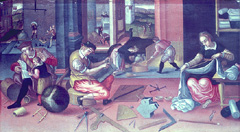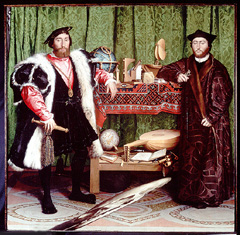
The Measurers,
Museum of the History of Science
click for larger image

Surveying the towers in Cosmographia

The Ambassadors,
The National Gallery, London
click for larger image
| Next Page | go back one page | Home |
| Even in its more mundane applications the utility of mathematics was clear to 16th century observers. This fact is graphically demonstrated in the painting The Measurers, which presents everyday 16th century uses of practical mathematics in gauging activities. In light of what has been said above it is unsurprising that the instrument maker sits in the center of The Measurers. |
 The Measurers, Museum of the History of Science click for larger image |
|||
| Practitioners themselves were very much aware of their utility and publicly promoted this notion to attract patronage and prestige. Indicative of the practitioners' confidence in the utility of their subject was their willingness to apply it in new ways and places. For instance, with the advent of artillery, mathematicians— as instrument makers, surveyors, and architects— were quick to demonstrate the utility of their discipline in gunnery, battlefield surveying, and fortification. Thus in war, as in astronomy, navigation and gauging, mathematicians actively engaged themselves and promoted their utility in affairs of state and commerce. |
 Surveying the towers in Cosmographia |
|||
| Related to the perceived utility of mathematics were the rhetorical roles played by its instruments in Renaissance society. Viewed in the context of real-world utility, mathematical instruments suggested action, learning and power. Many of the expensive and ornate mathematical instruments that survive in museum collections today were purchased by important and wealthy persons to serve just these rhetorical purposes. These palpable symbols of utility and education conferred prestige upon the patron who could afford, possess, use and understand them. This is often witnessed in the art of the 16th century, most notably in Holbein's The Ambassadors. |
 The Ambassadors, The National Gallery, London click for larger image |
|||
|
||||